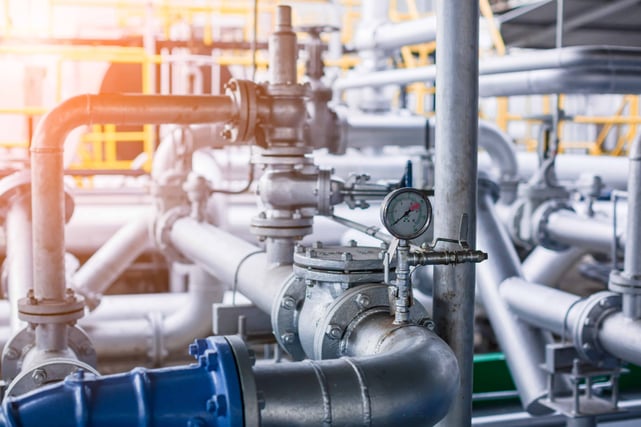Share this
Industrial Fluid Systems in Oil and Gas
by Morgan Zealear on 2/28/23 9:00 AM

When you need to transport process fluid within specified conditions, it's essential to have properly installed industrial fluid systems. In the oil and gas industry, the raw and refined fluid needs to be transported under controlled temperature and pressure conditions. The industrial fluid system will regulate and control the fluid flow through facilities for processing, refinement, and production phases.
The very nature of the fluid system is also one of the major pain-point for industries. Working with pressurized fluids can result in leaks, contamination, corrosion, and system failure when installation specifications haven’t been prioritized. In addition, the lack of quality parts, non-representative samples, and poor system assembly is a safety risk to the entire refinery. So today, we will explore these key installation issues and their solutions when assembling an industrial fluid system in the oil and gas industry.
Industrial Fluid System In the Oil and Gas Industry: Safety First
Industrial fluid systems in the oil and gas industry can be extensive, starting at remote extraction locations and running through wells to the refining facility. Installing and maintaining this vast system layout is a challenge, with potential chances of leaks and component failure in a highly pressurized system. When working with raw fluids, the chance of clogging, corrosion, and contamination is also present. These potential points of failure are risks to system safety and can result in system downtime and production loss.
An ideal industrial fluid system in an oil and gas refinery will require the use of high-quality grab sample stations, seal support systems, a process fluid delivery system, and analytical instrumentation. Often, the challenges of installation of these systems come from miscommunication during assembly, unnecessary complexity, incompatible component metallurgy, and incorrect analysis of process conditions. A quality control approach to these issues is required to achieve the system's efficacy.
Fluid System Installation And Maintenance: Things To Note
For efficient installation of the industrial fluid system in the oil and gas industry, these are the strategies to note, include:
1. Select the best possible componentsHigh-quality components are essential when building an industrial fluid system. Therefore, when selecting components such as valves, fittings, or tubings, it is crucial to examine:
- The material compatibility with the process fluid.
- The manufacturer’s specification of the component against the process condition (i.e., temperature and pressure limits).
- Standardization is important. It is recommended to not intermix/interchange tube fitting components, as there is no standard for tube fittings.
2. A simplified system design
An overcomplicated design only increases the risk of failure and complicates the troubleshooting process. A simplified design may look like:
- Using bent tubing instead of multiple fittings.
- Using manifolds and weldments to reduce excess routing and potential leak points.
- A centralized control system for easy troubleshooting.
A custom fluid system assembly allows you to optimize the design to fit your operating condition with an ideal assembly plan and high-quality components.
3. Consider all forces in actionOccasionally, the installation team forgets to account for the additional forces that arise from the fluid flow and other mechanical equipment. This includes:
- Vibration from pumps and motors.
- Pressure wave problem in the piping system.
The fluid system components must have proper support, so they don’t fail due to fatigue or strain. The system's hoses, tubes, and seals must be examined periodically for any compromises.
Identify Process Requirements And Design Efficient Fluid Systems
To achieve all the installation needs mentioned above, it is crucial that you are well aware of your process conditions and identify the issues early in the process. For this, you can work with your local fluid system expert, who can help you understand your fluid, fluid system, and fluid system design. Swagelok can help with:
- Setting up the grab sampling station: The sample station complies with all pressure, temperature, and flow control requirements, providing a more representative sample. Analysis of this sample is important for selecting the correct component and design plan that meets safety standards.
- Installing/Optimizing the seal support system: Depending on the pressure and temperature, vibration and strain, and fluid condition, it is possible to devise the ideal mechanical seal support plan to enhance the reliability and integrity of the fluid system.
- Designing a gas distribution system: A custom gas distribution system provides controlled inflow and outflow with continual supply. This is ideal for improving performance and minimizing downtime in refineries.
- Supplying high-quality components: High-quality valves, pressure controllers, tubings, and hoses that meet the specifications are key to the leak-free functioning of the industrial fluid systems in the oil and gas industry.
With a wide range of solutions from Swagelok, your oil and gas facility is guaranteed to have efficiency and productivity.
To find out more about how Swagelok Northern California can help enhance the performance of your industrial fluid systems in oil and gas refineries, contact our team today by calling 510-933-6200.
 About Morgan Zealear | Product Engineer, Assembly Services
About Morgan Zealear | Product Engineer, Assembly Services
Morgan holds a Bachelor of Science in Mechanical Engineering from University of California at Santa Barbara. He is certified in Section IX, Grab Sample Panel Configuration and Mechanical Efficiency Program Specification (API 682), and he is well versed in B31.3 Process Piping Code. Before joining Swagelok Northern, he was a manufacturing engineer at Sierra Instruments, primarily focused on capillary thermal meters for the semiconductor industry (ASML).
Share this
- Archive (465)
- Assembly Services (207)
- About (100)
- Seal Support Systems (96)
- Best Practices (88)
- Training Services (74)
- Fittings (51)
- Semiconductor Applications (49)
- Hoses and Flexible Tubing (47)
- Regulators (44)
- Tubing (42)
- Grab Sampling Systems (32)
- Sampling Systems (32)
- Gas Systems (30)
- Services (30)
- Downloads (29)
- Valves (24)
- Application Support (18)
- Orbital Welding (17)
- Case Studies (13)
- Steam Systems (13)
- Frequently Asked Questions (12)
- Tools (12)
- Measurement Devices (7)
- Subsystems (6)
- Thermal Management (6)
- September 2023 (1)
- August 2023 (2)
- June 2023 (1)
- March 2023 (3)
- February 2023 (3)
- January 2023 (4)
- December 2022 (4)
- November 2022 (4)
- October 2022 (4)
- September 2022 (1)
- August 2022 (3)
- July 2022 (2)
- June 2022 (4)
- May 2022 (1)
- April 2022 (2)
- March 2022 (1)
- February 2022 (2)
- January 2022 (3)
- December 2021 (1)
- November 2021 (6)
- October 2021 (6)
- September 2021 (8)
- August 2021 (4)
- July 2021 (3)
- June 2021 (6)
- May 2021 (6)
- April 2021 (7)
- March 2021 (5)
- February 2021 (4)
- January 2021 (6)
- December 2020 (5)
- November 2020 (6)
- October 2020 (6)
- September 2020 (8)
- August 2020 (7)
- July 2020 (8)
- June 2020 (8)
- May 2020 (6)
- April 2020 (9)
- March 2020 (7)
- February 2020 (10)
- January 2020 (21)
- December 2019 (23)
- November 2019 (21)
- October 2019 (22)
- September 2019 (21)
- August 2019 (22)
- July 2019 (23)
- June 2019 (20)
- May 2019 (23)
- April 2019 (22)
- March 2019 (21)
- February 2019 (20)
- January 2019 (21)
- December 2018 (14)
- November 2018 (19)
- October 2018 (23)
- September 2018 (17)
- August 2018 (29)
- July 2018 (11)
- June 2018 (6)
- May 2018 (5)
- April 2018 (4)
- March 2018 (5)
- February 2018 (3)
- January 2018 (3)
- December 2017 (2)
- November 2017 (4)
- October 2017 (3)
- September 2017 (2)
- August 2017 (6)
- July 2017 (4)
- June 2017 (4)
- May 2017 (4)
- April 2017 (3)
- March 2017 (4)
- February 2017 (3)
- January 2017 (3)
- December 2016 (3)
- November 2016 (3)
- October 2016 (3)
- September 2016 (5)
- August 2016 (5)
- July 2016 (4)
- June 2016 (5)
- May 2016 (3)
- April 2016 (4)
- March 2016 (5)
- February 2016 (11)
- January 2016 (1)
- December 2015 (3)
- November 2015 (4)
- October 2015 (3)
- September 2015 (4)
- August 2015 (4)
- July 2015 (8)
- June 2015 (5)
- May 2015 (3)
- April 2015 (4)
- March 2015 (4)
- February 2015 (3)
- January 2015 (4)
- December 2014 (2)
- November 2014 (3)
- October 2014 (4)
- September 2014 (4)
- August 2014 (4)
- July 2014 (5)
- June 2014 (4)
- May 2014 (4)
- April 2014 (5)
- March 2014 (4)
- February 2014 (3)
- January 2014 (4)
- December 2013 (5)
- November 2013 (3)
- October 2013 (4)
- September 2013 (3)
- August 2013 (5)
- July 2013 (5)
- June 2013 (5)
- May 2013 (3)
- April 2013 (6)
- March 2013 (4)
- February 2013 (4)
- January 2013 (8)
- December 2012 (4)
- November 2012 (6)
- October 2012 (6)
- September 2012 (4)
- August 2012 (4)
- July 2012 (4)
- June 2012 (4)

.webp?width=210&height=70&name=StickyLogo%20(5).webp)